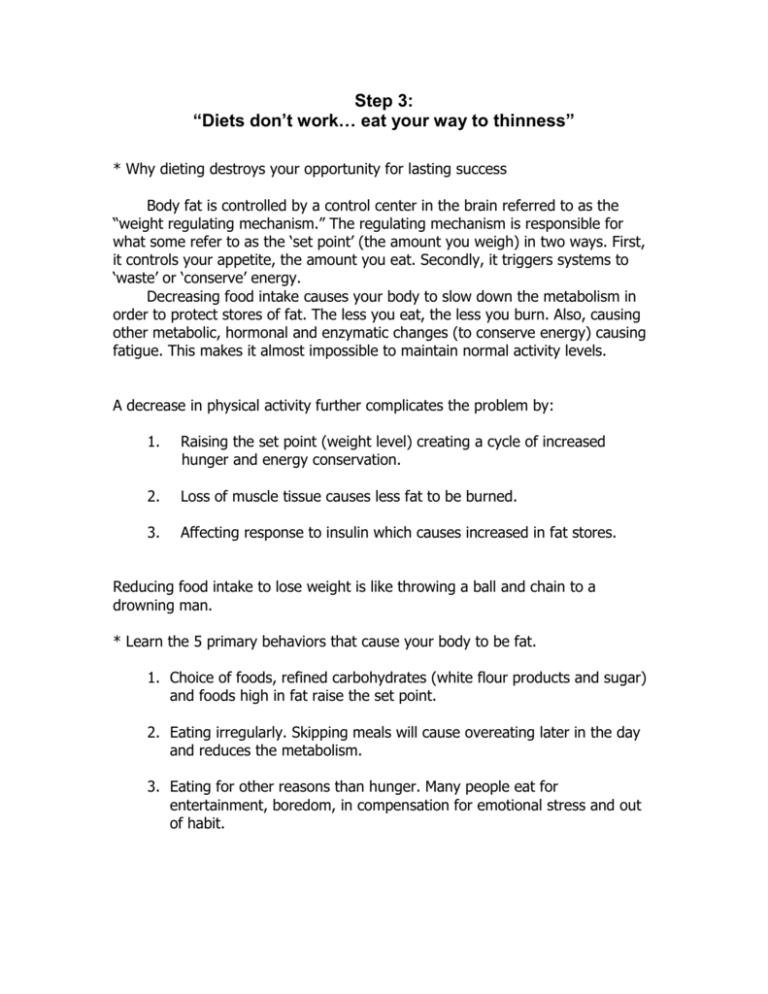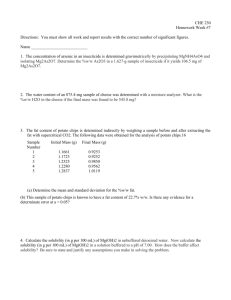FACT - TimShurr.com
advertisement

Step 3: “Diets don’t work… eat your way to thinness” * Why dieting destroys your opportunity for lasting success Body fat is controlled by a control center in the brain referred to as the “weight regulating mechanism.” The regulating mechanism is responsible for what some refer to as the ‘set point’ (the amount you weigh) in two ways. First, it controls your appetite, the amount you eat. Secondly, it triggers systems to ‘waste’ or ‘conserve’ energy. Decreasing food intake causes your body to slow down the metabolism in order to protect stores of fat. The less you eat, the less you burn. Also, causing other metabolic, hormonal and enzymatic changes (to conserve energy) causing fatigue. This makes it almost impossible to maintain normal activity levels. A decrease in physical activity further complicates the problem by: 1. Raising the set point (weight level) creating a cycle of increased hunger and energy conservation. 2. Loss of muscle tissue causes less fat to be burned. 3. Affecting response to insulin which causes increased in fat stores. Reducing food intake to lose weight is like throwing a ball and chain to a drowning man. * Learn the 5 primary behaviors that cause your body to be fat. 1. Choice of foods, refined carbohydrates (white flour products and sugar) and foods high in fat raise the set point. 2. Eating irregularly. Skipping meals will cause overeating later in the day and reduces the metabolism. 3. Eating for other reasons than hunger. Many people eat for entertainment, boredom, in compensation for emotional stress and out of habit. 4. Decreasing food intake. Causes the body to conserve instead of waste energy and to store fat instead of burning it. Eating plenty of the right kind of foods will allow your body to burn fat. 5. Lack of physical activity. The only way fat can be reduced and broken down involves muscular activity on a continuous and regular basis. * Correct nutrition fact, fad and fantasy The three principles that really work: 1. Exercise. Eating correctly, without exercise, will not cause the body to lose fat. This is the most important factor in the weight control process. Exercise lowers the set point, increases resting metabolic rate (amount of energy used when resting) and creates lean body mass (which uses fat stores for energy). 2. Correct food choices. Study after study has shown that weight gain is more dependent on what type of foods are eaten than their caloric content. Eating the right kind of foods actually caused the body to ‘waste’ rather than ‘conserve’ energy. First, decreased fat consumption. The average American consumes 40% of his caloric in the form of fat. Although most nutritionists disagree on what is the correct amount of fat, we suggest 20%, or fear of what the average American consumes. Secondly, reduce refined carbohydrates, (white flour products and sugar) and increase complex carbohydrates (whole grain products, vegetable, fruits, etc.) the quick release of sugar into the blood stream stimulates the release of insulin which decreases blood sugar and creates a strong desire to eat within a few hours of intake. Because complex carbohydrates are broken down more slowly, insulin is released at a more even level and energy levels don’t rise and fall as sharply. Thirdly, decrease high caloric fluids, including soda with artificial sweeteners, and increase intake of water. Drink at least 6 glasses of water each day. 3. Eat three meals a day. Some people will need to learn how to eat breakfast, but eating in harmony with natural drives will allow you more control over what you eat. The last meal of the day should be at least 4 hours prior to bedtime. Also, make at least one meal a day large enough to feel satisfied, (not uncomfortable full). If you get hungry between meals, have a snack. Recommended reading: “How to Lower Your Fat Thermostat” By Remington, Fisher and Parent. Published by Vitality House International. Master the 6 most important eating habits characteristics of naturally thin people. 1. Have a self image of being thin and energetic. 2. Be physically mobile to develop muscle that burns fat. 3. Like yourself, have self-esteem. 4. Understand your body’s relationship with food and exercise. 5. Control emotions, stress, and handle adversity without using food as a buffer. 6. Persistence and patience during goal attainment process. * Physical activity, fact and fiction, how much do you really need FACT Exercise on a consistent basis is mandatory for permanent weight loss. The type of exercise should have the following criteria: * Use large muscles - like the thigh muscle * Be continuous without interruption or breaks, like walking or bike riding. * Should increase breathing, but not to the point where you can’t carry on a conversation. * Start with 20 minutes EVERY DAY and gradually up to an hour. After reaching your weight goal, you may be able to exercise only 3 or 4 days a week to maintain. Walking, jogging, swimming and bike riding are good examples of moderate intensity exercise. It is important to note that the benefit of exercise is not the amount of calories burned while exercising. The more important and true benefits are: * * * * Lower set point Create muscle mass that burns fat Increase metabolic rate Reduces appetite FICTION Exercise does not increase appetite, high intensity exercise (heavy weight lifting for example) increases appetite, but moderate intensity exercise actually reduces appetite. The benefit of exercise is not the calories burned while exercising. Moderate intensity exercise causes your body to change how it takes energy from the body, actually cause stores of fat to be broken down.







